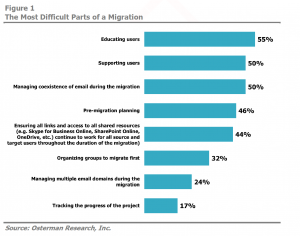Add value by bundling add-ons
The survey found that when it comes to functions such as archiving, discoverability and governance, only 13 percent of Office 365-enabled organizations believe it’s a complete solution. The other 87 percent believe that third-party add-ons are needed to satisfy these requirements. For SharePoint, while 18 percent of organizations believe it to be complete, 82 percent perceive the need for add-ons.
The generalist nature of Office 365 presents openings for lowering your clients’ cost-of-ownership while creating new opportunities for you. In Osterman’s analysis, many medium-sized and larger clients are better-served by skipping the higher-tiered Office 365 offerings, choosing a lower-priced package, and supplementing with best-of-breed solutions. This approach may better-satisfy their requirements for records management, archiving, security and encryption. It also potentially delivers higher margin for you. The migration might be more complex, but you’ll deliver significantly higher value to clients and differentiate your offering in the marketplace.
Don’t overlook education and user support
Pre-migration planning and execution is the core of any migration, but you might be surprised at the emphasis your clients place on managing the end-user experience. When asked about the most difficult aspects of the migration process, 55 percent said educating users, and 50 percent said supporting users. Compare this to the 46 percent who mentioned difficulty in planning the migration, and 32 percent who said organizing the groups to migrate first.

These findings point to a real opportunity to bundle user education and support into your migration offering. Especially if you’re migrating from on-premises Exchange Server and Office to Office 365, there are a host of new collaboration tools at users’ fingertips that will be brand-new to them. Bundle end-user training services into a more complete migration offering.
Build them once, and you’ll have a repeatable revenue source that you can leverage in other projects.
Don’t sell yourself short — your skills are essential to client success
While 68 percent of organizations use their own internal resources to conduct a migration, most also turn to outside resources. These include 46 percent who retain outside consultants, 30 percent who turn to a third-party’s professional services organization, and 17 percent who use a third-party vendor. As the survey authors conclude, “A migration project is not for the faint of heart.” It requires skills, tools and experience that are not always present in IT organizations.
There are critical decisions to make, calling for careful planning. Knowledge of the potential pitfalls is essential. There are many things that can go wrong, potentially impacting business continuity and employee productivity, as well as leading to potential regulatory exposure.
The report cautions against do-it-yourself migrations. The authors recommend the use of migration tools that bake-in successful processes developed over the course of many migrations. Equally important is outside firms like yours who know how to use them well.



